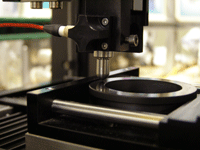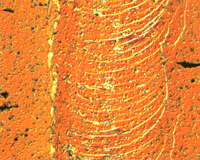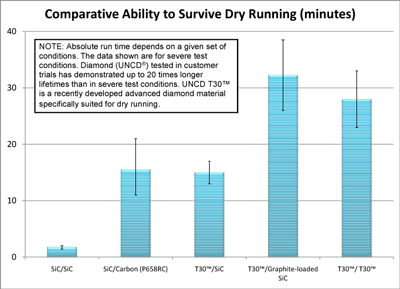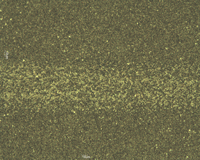The growing body of diamond performance data is casting doubt on past assumptions about the ideal face materials for dry-running and poorly lubricated applications. A new family of diamond-enhanced silicon carbide (SiC) seal faces has resulted in increased reliability and mean time between repairs (MTBR) of mechanical seals in a wide range of demanding applications. Demonstrated in field use, the increased performance of these new diamond sealing components is the result of the outstanding mechanical, thermal and chemical properties of diamond.
Diamond's ability to reduce the amount of frictional heat generated at the seal face enables the seal to survive poorly lubricated or intermittent dry-running conditions. The low friction and reduced heat generated on the seal face calls into question the common wisdom that a hard face matched with a carbon counterface is the most appropriate face pair combination to address dry-running and poorly lubricated applications.
Diamond-faced seals have been shown to run dry for longer periods of time, without reaching critical temperatures, than uncoated silicon carbide running against carbon. Diamond faced seal rings are being installed into customer applications by several major seal manufacturers for situations where face lubrication is an issue, including hot-water and light hydrocarbons. Diamond seal rings have also shown increased seal life in traditional hard-on-hard face sealing applications such as heavily loaded slurries found in mining, paper processing and drilling operations.
How is a Diamond Seal Manufactured?
Diamond-faced seal rings are made by growing the diamond from a carbon-bearing gas source such as methane (CH4) in the presence of hydrogen (H2) at high temperatures, approximately 1,475 deg F (800 deg C) onto the surface of a silicon carbide ring. The diamond forms a dense, continuous surface on the SiC with surface finishes and properties that can be tailored for a variety of sealing applications. The surface finish of the diamond when applied to a silicon carbide ring can be accurately controlled to produce a range of finishes-from a polished surface with a roughness of <1 micro-inch (25 nanometers) Ra to matte finishes of 10 micro-inches (300 nanometers) and above. The diamond deposition process enables the production of diamond-faced rings that can be used in combination with a wide range of counterfaces according to the application's needs. Diamond-faced rings are being successfully run in the field against carbon faces, silicon carbide and against other diamond faces.
Another important feature of the diamond coating process is its ability to closely replicate the underlying SiC surface and maintain the ring's original flatness. After deposition, diamond coated rings maintain the flatness of the silicon carbide ring to deviations well below 2 light-bands of helium (approximately 600 nanometers).
Diamond Adhesion on SiC
Due to major technological advances, coatings now serve successfully in critical and demanding tribological applications including components in race car engines, bearing surfaces in artificial heart valves and jet engine blades. The mechanical seal industry has recognized the advanced performance of coatings and modified both the API 682 and ISO 21049:2004 (6.1.6.2.5) standards to now state that "wear resistant materials such as silicon carbide or tungsten carbide may be enhanced by applying a coating." To ensure that engineered surfaces (coatings) provide the desired performance and reliability benefits in tribological applications, it is critical that coatings tenaciously adhere to the underlying substrate material. To ensure that diamond seals meet this requirement, a modified version of the ASTM C 1624-05 adhesion test (Standard Test Method for Adhesion Strength and Mechanical Failure Modes of Ceramic Coatings by Quantitative Single Point Scratch Testing) was developed that focused on the specific demands of evaluating diamond coatings on silicon carbide.
Figure 1 shows the adhesion test of a diamond-faced O-ring stationary seat. This adhesion standard is routinely applied to hard coatings where exceptional adhesion eliminates the possible use of simpler methods. These simpler methods typically measure the force required to pull the coating off the surface and represent the results as the force per unit area at which the coating separates. These methods are limited by both the strength of the attachment point used to pull on the film and the intrinsic strengths of the underlying materials (in this case silicon carbide). When extremely well bonded coatings are required, ASTM C 1624-05 is one of the most reliable methods of quantifying adhesion properties.

Figure 1. Adhesion testing of diamond (T30) seal face
The ASTM C 1624-05 procedure results in a numeric value for coating adhesion, represented by the critical load required to damage the film. Dragging a diamond indenter over the coated surface while simultaneously increasing the load on the indenter normal to the surface creates the damage. To enable the testing of diamond coatings, the diamond indenter was replaced with a silicon nitride (Si3N4) sphere whose radius was 0.03125 inches (approximately 790 micrometers). This modified procedure enabled the ball to be rotated and exchanged so that a fresh, consistent surface could be presented against the diamond coating for each test.
We conducted a series of experiments focusing on diamond deposition variables with the goal of demonstrating that diamond coatings on silicon carbide rings would not fail at loads that significantly exceed the compressive strength of the underlying silicon carbide. Uncoated self-sintered silicon carbide rings were evaluated using the same test method. The results showed consistent cracking and intrinsic failures at indenter loads of approximately 460 ksi (approximately 3,200 MPa). Figure 2 shows a micrograph illustrating the typical failures that occurred on uncoated silicon carbide surfaces as a result of adhesion or scratch testing. Diamond-coated silicon carbide rings were engineered to consistently show no modes of failure at indenter loads up to the capability of the adhesion test platform, 920 ksi (approximately 6,400 MPa), which is almost twice the typical compressive strength of the SiC. Figure 3 shows the undamaged surface of the typical diamond film exposed to these high loads.

Figure 2. Critical load showing fracturing of un-coated SiC at 3200 MPa (460 ksi)
Figure 3. No failures of diamond (T30) at loads of 6400 MPa (920 ksi)
Dry-Running Resistance
Diamond-faced seals have provided superior ability to withstand damaging intermittent conditions and continue to seal. To evaluate diamond's ability to withstand intermittent dry-running, we developed a test protocol whose primary metric was to determine how long a seal can run dry before reaching a critical temperature of 500 deg F (which damages secondary elastomeric seals and renders the seal unrecoverable). Following the dry-running interval, ambient temperature water was reintroduced into the dry-running pump to demonstrate that the seal could successfully recover. After demonstrating recovery, the test was stopped and the seal broken down and inspected. Both self-sintered SiC rings running against a resin-bonded carbon (SiC/Carbon) and SiC running against SiC (SiC/SiC) were evaluated to set a baseline of performance.
Under this demanding test protocol, the typical dry-running times of a SiC face running against another SiC face (SiC/SiC) were 60 to 90 seconds (see Figure 4). The time interval was so short and the temperature rise so fast that it was difficult to reintroduce water before the ring cracked or the elastomers were so damaged that the seal leaked severely. The dry-running time of SiC against resin-bonded carbon (SiC/Carbon) averaged 15.5 minutes. It is important to note that the specific times reported (duration of dry running) are dependent on a variety of specific details regarding the seal and its operation. This dry-running test was not designed to provide an accurate prediction of the dry-running time in a given application. Rather, it was designed to provide a set of comparative data which provides insight into how face materials can increase a seal's robustness if dry-running or extreme intermittent loss of lubrication is a failure mechanism.
Figure 4 contains a summary of the dry-running times for the evaluated face combinations. The material identified as T30TM is one of a family of face materials that consists of a diamond-faced, self-sintered SiC engineered specifically to address the demanding requirements of hard-on-hard applications. Unlike the 60 to 90 seconds of dry running achieved by a SiC/SiC pair, T30 running against SiC (T30/SiC) achieved more than 15 minutes of running dry before reaching critical temperature, and it then recovered successfully after the reintroduction of water.

Figure 4. Dry-running performance of diamond (T30) with various face combinations
The dry-running resistance of diamond-faced seal rings run against self-sintered silicon carbide (T30/SiC) was comparable to, and had less variance in these evaluations, the conventionally accepted solution of running silicon carbide against carbon (SiC/Carbon). The dry-running performance of diamond against diamond (T30/T30) provided significantly increased times over the uncoated combinations, but it did not provide an improvement over the average 32 minutes of dry-running time for a diamond face running against a graphite-loaded silicon carbide (T30/Graphite-loaded SiC).
Continued tests are being made to help engineer and develop new face combinations that are more robust and resilient to intermittent dry-running. Commercially available diamond products sold by major seal manufacturers today can run dry against conventional SiC counter faces or against diamond and can significantly increase a mechanical seal's ability to survive intermittent dry-running conditions.
Conclusion
Due to superior adhesion and other advancements, diamond coating technology is today being used in a wide range of sealing applications. The adhesion of new UNCD® Fface materials to their underlying silicon carbide rings is so high they can withstand loads that fracture the SiC without separation of the diamond from the SiC ring. The variety of available surface finishes and material properties enable seal designers and manufacturers with a set of candidate materials that can be paired with a wide range of counter-faces to address both the technical and economic considerations for a seal application. The benefits that diamond brings to mechanical seals are actively being applied to similar tribological applications such as hydrodynamic bearings for tilting pad bearing applications as well as more traditional thrust and journal bearing applications.
Pumps and Systems, April 2010


